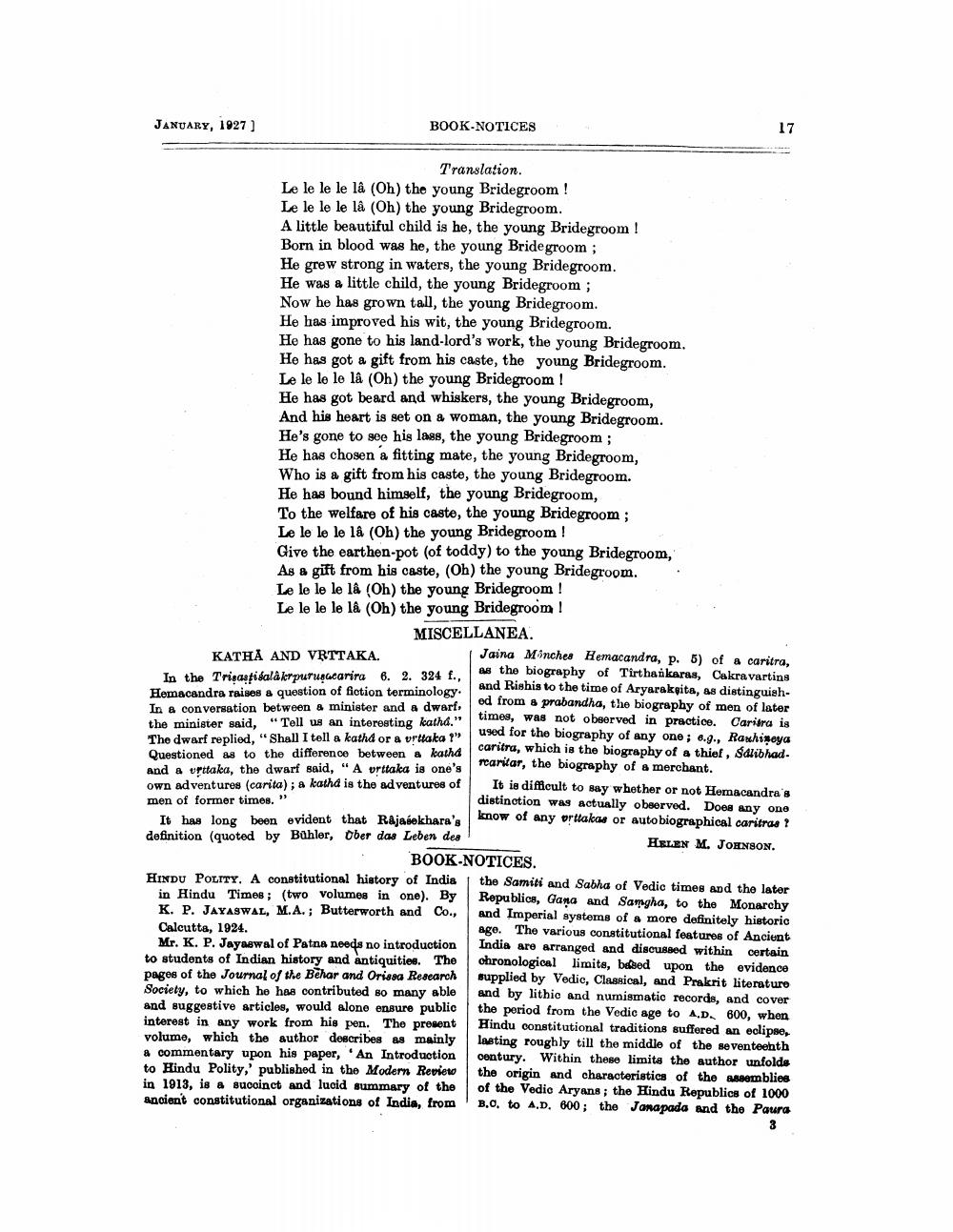________________
JANUARY, 1927]
BOOK-NOTICES
Translation.
Le le le le lâ (Oh) the young Bridegroom! Le le le le lâ (Oh) the young Bridegroom. A little beautiful child is he, the young Bridegroom! Born in blood was he, the young Bridegroom; He grew strong in waters, the young Bridegroom. He was a little child, the young Bridegroom; Now he has grown tall, the young Bridegroom. He has improved his wit, the young Bridegroom. He has gone to his land-lord's work, the young Bridegroom.
He has got a gift from his caste, the young Bridegroom.
Le le le le lâ (Oh) the young Bridegroom!
He has got beard and whiskers, the young Bridegroom, And his heart is set on a woman, the young Bridegroom. He's gone to see his lass, the young Bridegroom; He has chosen a fitting mate, the young Bridegroom, Who is a gift from his caste, the young Bridegroom. He has bound himself, the young Bridegroom,
To the welfare of his caste, the young Bridegroom; Le le le le lâ (Oh) the young Bridegroom!
Give the earthen-pot (of toddy) to the young Bridegroom, As a gift from his caste, (Oh) the young Bridegroom. Le le le le lâ (Oh) the young Bridegroom! Le le le le lâ (Oh) the young Bridegroom! MISCELLANEA.
KATHA AND VRTTAKA.
In the Trisaspisalâkrpurusacarira 6. 2. 324 f., Hemacandra raises a question of fiction terminology. In a conversation between a minister and a dwarf, the minister said, "Tell us an interesting katha." The dwarf replied, "Shall I tell a katha or a vṛttaka?" Questioned as to the difference between a katha and a vṛttaka, the dwarf said, "A vrttaka is one's own adventures (carita); a kathd is the adventures of men of former times. "
It has long been evident that Rajasekhara's definition (quoted by Bühler, Ober das Leben des
HINDU POLITY. A constitutional history of India in Hindu Times; (two volumes in one). By K. P. JAYASWAL, M.A.; Butterworth and Co., Calcutta, 1924.
BOOK-NOTICES.
Mr. K. P. Jayaswal of Patna needs no introduction to students of Indian history and antiquities. The pages of the Journal of the Behar and Orissa Research Society, to which he has contributed so many able and suggestive articles, would alone ensure public interest in any work from his pen. The present volume, which the author describes as mainly a commentary upon his paper, An Introduction to Hindu Polity,' published in the Modern Review in 1913, is a succinct and lucid summary of the ancient constitutional organizations of India, from
17
Jaina Minches Hemacandra, p. 5) of a caritra, as the biography of Tirthankaras, Cakravartins and Rishis to the time of Aryarakeita, as distinguished from a prabandha, the biography of men of later times, was not observed in practice. Caritra is used for the biography of any one; e.g., Rashineya caritra, which is the biography of a thief, Salibhad. caritar, the biography of a merchant.
It is difficult to say whether or not Hemacandra's distinction was actually observed. Does any one know of any evrttakas or autobiographical caritras?
HELEN M. JOHNSON.
the Samiti and Sabha of Vedic times and the later Republics, Gana and Samgha, to the Monarchy and Imperial systems of a more definitely historic age. The various constitutional features of Ancient India are arranged and discussed within certain chronological limits, based upon the evidence supplied by Vedic, Classical, and Prakrit literature and by lithic and numismatic records, and cover the period from the Vedic age to A.D. 600, when Hindu constitutional traditions suffered an eclipse, lasting roughly till the middle of the seventeenth century. Within these limits the author unfolds the origin and characteristics of the assemblies of the Vedic Aryans; the Hindu Republics of 1000 B.O. to A.D. 600; the Janapada and the Paura 3




